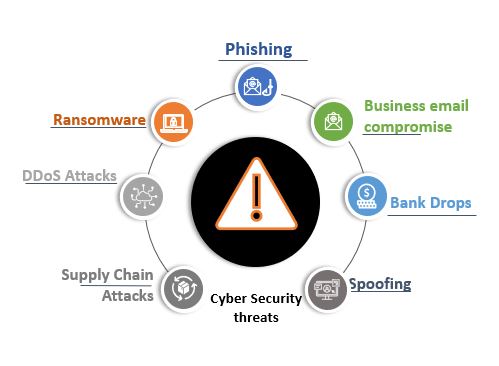Overview of Cybersecurity in Organization
Cybersecurity in Organization
As a business that, continues to improve its service through information technology the same as should be abreast of the threats. Cyber threats keep growing at a rapid pace as Tactics and attack methods are changing and improving day by day.
These articles will show you the types of cyber threats and measures to prevent the threats to define the proper strategies to identify the likelihood of cybersecurity events.
What is Cybersecurity?
Cybersecurity is the security control or measures put in place of protecting critical systems, networks, programs, and sensitive data from cybercriminals., whether those threats come from inside or outside of the organization.
What Is a Cyber Security Threat?
A cybersecurity threat is any malicious way a cybercriminal aims to gain unauthorized access, damage data, or stealing of sensitive data. Cyber threats originate from various parties including displeased employees within the organization, terrorist gangs, and hackers
What are the five types of cyber security for organizational safety?
– Critical infrastructure security
– Application security
– Cloud Security
– Network security
– Internet of Things (IoT) security
Types of Cyber Security Threats
Here are common cybersecurity threats
Phishing: This is a method of fake communication to trick users into divulging login credentials to gain access to an internal network. Example (scam emails seem very convincing, especially when they’re presented with a sense of urgency)
Ransomware: Cybercriminals lock victims out of their computers by encrypting them with malware software. (The damage is only reversed if a ransom is paid.)
DDoS Attacks: Distributed Denial-of-Service (DDoS) relating the victim’s server being overwhelmed with fake connection requests, forcing it offline. Example (Login of customer accounts portal, payment portals, etc.)
Supply chain attacks: make it possible for cyber attackers to circumvent security controls by creating avenues to sensitive resources through a target’s third-party vendor.
Bank Drops: Cybercriminals often store stolen funds in fake bank accounts (bank drops) opened with stolen customer credentials.
Business Email Compromise: An Attacker obtains access to the business email account and imitates the owner’s identity to defraud the company and its stakeholder
Spoofing: Harker finds a way to impersonate a banking website’s URL with a similar website.

How do you ensure cyber security in an organization?
The following security controls could address most of the exposures facilitating data breaches in the financial services sector:
Email Address – In the organization management and staff should see to it that all email send to them is from the right source and check the document attached to the email is the right doc extension.
Firewall – The IT team in the organization regularly updated the firewall and proper configuration of the device to be capable of detecting and blocking malware injection attempts from cyber attackers.
Multi-Factor Authentication – The organizations should incorporate An MFA policy on devices that will make it very difficult for threat actors to compromise privileged credentials.
Attack Surface Management – An attack surface management solution capable of detecting data leaks will significantly reduce the chances of a successful data breach, both internally and throughout the vendor network.
Third-Party Risk Management (TPRM) – A third-party risk management program will identify security vulnerabilities for all third-party cloud services to prevent supply chain attacks.
Again, You can read on ,Cybersecurity in Banking Fraud,Cybersecurity Incident Response Plan and Threat Intelligence in Cybersecurity.
I will also recommend you read the post on Data protection in Cyber security, How Does Cloud Computing Technology Work, Turn ON or Off Two Factor(2F) Authentication for your Gmail using your Phone Number, Add alternative Email or Phone to Reset Account Password in the event of forgetting your Login credential , How to Use Google Translate and How to Login to Gmail Account, Sync Phone contact, Export Contacts from Gmail Account to Phone it could be of help.
Conclusion
Now, you must have an idea of Overview of Cybersecurity in an Organization. Ask your questions in the comments below. Try to follow us on Facebook, Instagram , and Twitter. Also if the post has helped you Kindly subscribe to our YouTube channel to continue learning.

